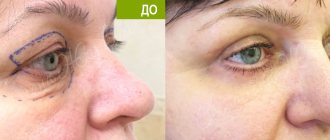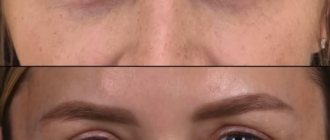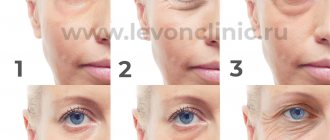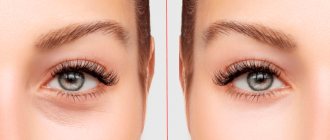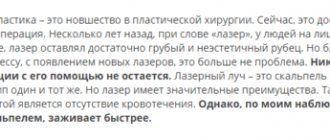Transconjunctival blepharoplasty is a type of surgical correction of the lower eyelid, in which surgical access is carried out from the conjunctiva. There are no incisions on the outside of the eyelid. Such an intervention avoids the appearance of a visible scar, but has moderate capabilities. It is used primarily to redistribute fatty tissue and eliminate bags under the eyes.
Transconjunctival blepharoplasty can reduce the recovery period to 10-15 days. For comparison, with the classical approach, complete healing takes about 1 month. The intervention is performed under local anesthesia, but if you want to sleep during the operation and have no contraindications to the administration of anesthesia, our anesthesiologist will administer general anesthesia.
Eyelid lift using transconjunctival blepharoplasty
“That which is inaccessible to man is visible to the eye,” said the Eastern sage.
Especially to a woman’s gaze: “The look will say everything... What is not allowed to the lips, what you hide from yourself...” He is capable of instilling hope, beckoning, calling, depriving sleep. Or take away your dream. Burn the bridges once and for all. Everything is in the power of a woman when her gaze is irresistible. Young, bright, open eyes have mystical power. But it’s enough to make your eyelid a little heavier, and witchcraft gives way to everyday life: no matter how much meaning you put into your gaze, the recipient will only read fatigue in it. And the reason for this is not always age - genetic predisposition, lifestyle, diseases and other reasons often lead to the appearance of the notorious “bags” and bruises under the lower eyelid in very young people. These bags are very prone to swelling, and the delicate skin of the lower eyelid is subject to constant stress associated with regular stretching and then contraction. Therefore, age-related changes in the form of a fine network of wrinkles and the appearance of excess skin on the lower eyelid appear early. It is useless to combat such phenomena with compresses, creams, and massage.
You can experiment for a long time and waste your precious youth searching for a home remedy. Or you can solve the problem within an hour in order to forget about it for many years and even forever.
Transconjunctival blepharoplasty photo
You can see photos of transconjunctival blepharoplasty on the website of the Abrielle plastic surgery clinic in the Photo Gallery section.
Days 4-10
At this time, it is especially important to strictly follow the doctor's recommendations.
By the tenth day, bruises and swelling will completely disappear. There will be no traces of intervention. Therefore, patients feel that they have fully recovered and can return to their usual rhythm of life. But that's not true.
Your body is still recovering from surgery. Now you may not see it.
Compliance with the rules described above will help him get back to normal faster, and you will avoid complications.
By the way, patients after transconjunctival blepharoplasty are allowed to return to work only on the eighth day after surgery.
Transconjunctival blepharoplasty
If, despite your young age (25-30 years), you are already the “lucky” owner of pronounced bags under the eyes, and the skin of the lower eyelid is elastic, not stretched or the excess is insignificant, transconjunctival blepharoplasty solves the problem - an extremely effective and at the same time the most gentle method surgical removal of fatty hernias of the lower eyelid.
Correction by this method gives a very quick and long-term result, causes a minimum of discomfort, leaves no visible marks (scars), complications or undesirable effects. The patient undergoes a micro-incision on the lower eyelid from the side of the mucous membrane (conjunctiva), through which the plastic surgeon removes fatty hernias, restoring lightness to the eyelid and youth to the eyes and face.
Transconjunctival blepharoplasty, in most cases, takes no more than an hour and is performed on an outpatient basis. A few hours later the patient returns home, and after 7-10 days—that’s how long the rehabilitation period lasts—a different, transformed, significantly prettier and younger face is reflected in the mirror.
Reviews about blepharoplasty
“The good aura of the clinic, the amazing selection of staff, unity, team building, high professionalism - all this in one... in the Abrielle plastic surgery clinic. Thank you, low bow to you, my dears, for your beautiful hard work. Patients who have visited this clinic once in the future, if they want to again correct something in their appearance, I am sure, will only come to the Abrielle clinic!” Tatiana, 51
A year and other reviews of blepharoplasty at the Abrielle aesthetic surgery clinic.
Preparing for surgery
During the first meeting, I will evaluate you and determine whether the transconjunctival approach can achieve your goals. If this turns out to be possible, you will need to undergo a standard preoperative examination: a surgical complex of laboratory tests, an ECG, and a consultation with a therapist. All this is done during the day at my clinic in Moscow. With the permission of your attending physician, a few days before the procedure, it is recommended to take medications (thrombo-ass, aspirin-cardio) and refrain from using cosmetics.
Transconjunctival blepharoplasty technique
The plastic surgeon performs preoperative markings for transconjunctival blepharoplasty directly on the operating table. The incision site is usually located in the middle of the inner surface (conjunctiva) of the lower eyelid.
Figure 1. Preoperative view. The changes in the lower eyelid are schematically shown: bags and bruises under the eyes, without pronounced excess skin.
Figure 2. The dotted line shows preoperative markings.
Before eyelid lifting, infiltration is performed - the introduction into the tissue of the lower eyelid to facilitate detachment of a special solution, which consists of a physiological solution with the addition of an anesthetic (pain relief) and adrenaline (for vasospasm and reduction of bleeding). An incision 1.5 - 2 cm long is always made with a scalpel to minimize tissue trauma. There are three packages of hernias on the lower eyelid, which are sequentially isolated and excised.
Figure 3. Making an incision with a scalpel along the preoperative marking line.
Figure 4. Isolation of three hernial bags of the lower eyelid and their removal.
Figure 5. Applying a cosmetic suture to a postoperative wound.
Figure 6. View after transconjunctival blepharoplasty.
A wrapping or subconjunctival suture is applied to the postoperative wound using a self-absorbing thread. Some plastic surgeons do not close the postoperative wound at all when performing transconjunctival blepharoplasty.
The great advantage of this operation is the ease of execution and the absence of postoperative scars.
Recovery period
Until the surgical wound is completely healed, you may experience certain inconveniences: a feeling of a foreign body, a feeling of dryness, swelling, hematomas. This is normal and should not make you worry. To alleviate your condition, I can prescribe special moisturizing and antimicrobial drops, as well as physical procedures that promote rapid resolution of swelling.
Until complete recovery, avoid increased eye strain. It is better to give up prolonged reading, watching TV, and working at the computer. You should also not take a hot bath or visit a sauna or bathhouse. Significant physical activity is contraindicated. To make sure the healing process is progressing as it should, I have to inspect the stitch periodically. It will be necessary to come to see me several times.
When you turn to me for help, you can be sure that the operation will be performed according to the standards of the best clinics in Europe. I regularly learn from the experience of colleagues from Germany, Italy, Japan and other countries with developed medicine. I have been working in the field of aesthetic surgery since 1996, which allows me to talk about myself as a fairly experienced surgeon.
During my practical activities, I performed operations on artists, politicians, and scientists. This is a fairly demanding and sophisticated category of clients, but all of them were satisfied with the result. Today I have a Candidate of Medical Sciences degree, the highest qualification category, and am a member of the Russian and international society of plastic surgeons.
Transconjunctival blepharoplasty and laser treatment
Such an effective, fast and comfortable method of removing fat deposits is also in demand by those whose problem is more extensive: with age, more significant excess skin appears on the lower eyelid (after 35–37 years).
In an effort to help patients, doctors have developed a new method that combines invasive and hardware techniques and provides a pronounced aesthetic effect. The method consists of sequential transconjunctival eyelid lifting and laser treatment of the skin around the eyes and the entire face.
When the fatty hernias are removed, the plastic surgeon uses laser resurfacing of the skin of the eyelids (if there is significant excess) or performs fractional rejuvenation (if there is moderate excess). The complex procedure has an impressive result: bags and fine wrinkles disappear, the skin around the eyes becomes smooth, elastic, and glows with youth. The addition of transconjunctival blepharoplasty with laser technology allows the skin of the eyelids not only to shrink, but also evens out the relief, increases firmness and elasticity, and eliminates the network of fine wrinkles.
“This look can express everything so wonderfully...” (A. S. Pushkin)
You can keep saying “Go away!” and your eyes will make him stay. You can say: “No,” but by the look he will understand everything and do everything right... A young look, not burdened by fatigue, can not only speak - it magically transforms the entire face, adding beauty and charm to it.
So is it worth doubting when there is an opportunity to change not only your outlook, but also your life?...
Features of plastics
Conjunctival blepharoplasty is a complex surgical operation that requires highly qualified and experienced surgeons. The duration of correction is from 1 to 1.5 hours. Local anesthesia is used for pain relief. General anesthesia is used in rare cases. The Correct Clinic offers two methods of blepharoplasty: classic (with a scalpel) and laser.
If it is necessary to perform transconjunctival blepharoplasty of the upper eyelid, the surgeon makes a puncture or incision from the inside of the eyelid along the conjunctiva. An endoscope is inserted through this access. As a result of plastic surgery, one can achieve eyebrow lifting, elimination of drooping eyelids and elimination of other defects of the upper eyelid.
With conjunctival blepharoplasty, a method of installing implants can be used to increase the elasticity of the skin and create the missing volume of tissue under the skin.
When performing lower transconjunctival blepharoplasty, punctures are made on the inner eyelid. Plastic surgery is performed to remove a hernia or excess fatty tissue.
Sutures are applied on the inside of the eyelid using self-absorbable threads. When using another material, the sutures are removed after 4–6 days. If a laser is used instead of a scalpel, no stitches are required.
Contraindications
The procedure is not recommended for the following conditions and diseases:
- minor age;
- infectious and viral diseases in the acute stage;
- presence of menstrual bleeding in women;
- malignant neoplasms in any tissues and organs;
- hormonal imbalance, pathologies of the endocrine glands;
- any disturbances in the circulatory system;
- increased bleeding time, decreased blood clotting;
- increased intraocular pressure or glaucoma;
- high blood pressure;
- autoimmune disease (rheumatoid arthritis, systemic lupus erythematosus, autoimmune reactions in thyroid diseases);
- dry eye syndrome – insufficient hydration in the absence or reduced secretion of tear fluid;
- congenital or acquired immunodeficiency.
Some of these contraindications are temporary. When their effect is completed, the doctor can give a referral for surgery.
If the patient has a serious illness of the body, blepharoplasty is completely prohibited.
What drugs should I use?
During rehabilitation after laser or classical blepharoplasty, the doctor prescribes medications for external use that stimulate the resorption of bruises and the reduction of swelling. Some ointments or creams may be prescribed to relieve itching and speed up tissue regeneration. It is important to remember that you cannot prescribe medications for yourself, since the wrong prescription can ruin the result of the correction.
In addition to medications, physiotherapy may be indicated - microcurrents, darsonval and others. These treatments also stimulate faster tissue repair in the damaged area. But before you sign up for a particular procedure, you should definitely discuss it with your surgeon.
To speed up tissue healing, special ointments are used.
In rare cases, antibiotics and other antibacterial medications may be prescribed to minimize the risk of infection. Analgesics are also sometimes prescribed if the patient complains of acute pain.
Possible complications
During the procedure, as well as during the rehabilitation period, the following complications may occur in the patient’s body:
- bleeding from the area of tissue damage;
- corneal bruises, if they are minor, the doctor does not prescribe any medical manipulations, they resolve on their own; in case of extensive bruises, injections of drugs into the eyeball can be used;
- internal hemorrhage near the eyeball, resulting in the formation of a hematoma that does not resolve for a long time;
- damage to the tissues of the eyeball during surgery, which are the most dangerous for the condition of the patient’s visual organs;
- severe bleeding that the doctor cannot stop for a long time;
- formation of age spots under the eyes;
- infection with a bacterial infection with the possibility of suppuration, the formation of cysts and abscesses, this is dangerous for the patient, since the bacterial infection can enter the blood through damaged vessels;
- the appearance of chronic dry eyes with damage to the corneal layer, in this case the patient is prescribed moisturizing drops or injections into the eyeball with special preparations for life;
- severe swelling that does not go away for a long time after surgery;
- increased tearfulness, this condition subsequently disappears with tissue healing;
- deformation of the eyelid, due to which it becomes inverted, which causes dry eyes, inflammation and redness of the surface layer;
- excessive tissue scarring;
- photophobia, accompanied by increased lacrimation, redness of the eyes and spasm of the eyelids;
- decreased visual acuity, which most often recovers within 1 month after surgery;
- increased intraocular pressure, which can subsequently form glaucoma.
If the patient chooses a highly qualified surgeon, the risk of complications is significantly reduced. But with health problems, especially in old age, certain risks remain. Therefore, doctors recommend a comprehensive examination of the body before the procedure.
What else do you need to know about rehabilitation after blepharoplasty?
In the first days, it is undesirable to allow water, and especially detergents, to get into the intervention area. Personal hygiene is not prohibited, but it is advisable to wash your hair as in a hairdresser - with your head thrown back.
Of course, it is worth limiting the use of equipment such as a computer, smartphone, TV, etc. as much as possible.
In summer, it is necessary to use protective creams with a high SPF level, and also wear sunglasses. You will have to give up contact lenses, as well as makeup - cosmetics are allowed only some time after the operation, but only hypoallergenic ones or those marked “for sensitive skin.” It is better to discuss any care products with your surgeon in advance.
Compliance with recommendations, following the rules and prohibitions is an important stage in rehabilitation after blepharoplasty of the upper or lower eyelids. Only an integrated approach will allow you to get the look of your dreams.
Other consequences
Complications after lower eyelid blepharoplasty include, for example, ectropion - inversion of the lower eyelid. The reason is the removal of too much tissue. Over time, an unpleasant cosmetic defect can even develop into an ophthalmological disease. Fortunately, ectropion can be eliminated either with medical therapy or surgery.
Another unpleasant consequence is the introduction of infection into the wound and the development of inflammation. Successfully treated with antibiotics. After transconjunctival blepharoplasty, a complication may be increased lacrimation, which does not stop even after the swelling subsides - this may be due to movement or scarring of the tear ducts.
Properly performed blepharoplasty does not entail risks.
With circular blepharoplasty, complications can be, as with any other type of correction, delayed, that is, they can appear later. For example, violation of eyelid closure, drooping of the upper eyelid, cyst, etc.
